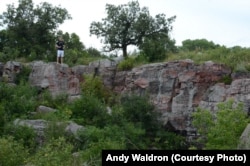The year 2016 is the 100th anniversary of the U.S. National Park Service. Adventurer and traveler Mikah Meyer is celebrating in a big way. He is traveling all across America. He plans to visit each of the more than 400 National Park Service sites.
Meyer is 30 years old. If he reaches his goal, he will become the youngest person to visit all of the sites within the National Park Service. He will also be the only person to ever do so in one trip.
He started his journey in Washington, DC, in June. Since then, he has visited more than 30 sites.
The Voice of America has been following Meyer on the road. His photos and blog provide audiences with a virtual view of some of the most beautiful places within the park system.
Meyer recently traveled around the northern U.S. states. During his travels, he visited two park service sites that Native Americans considered sacred.
Pipestone National Monument
The Pipestone National Monument is in southwestern Minnesota. It was created in recognition of the red pipestone found in the area.
The special stone is the main reason the place has been sacred to Native Americans for several hundred years. They used the stone to make pipes for prayer services.
During his visit, Meyer said he watched a park staff member making pipes at the park’s gift shop. The staff let Meyer use some tools to work with the stone himself.
“It was fun to be able to use it with your own hands,” Meyer said.
Effigy Mounds National Monument
Another place that holds special meaning for Native Americans is a national monument in the state of Iowa. It is connected with the culture known today as the Effigy Moundbuilders.
Here in Iowa, there are more than 200 small hills, or mounds, of earth. They are in the shapes of birds, bears, deer, bison, turtles, and panthers. They sit in one of the most scenic parts of the Upper Mississippi River Valley. They are part of the Effigy Mounds National Monument.
The exact purpose of the mounds remains unclear. But Native Americans say ancestral stories describe the mounds as ceremonial and sacred sites. Archaeologists believe the effigy mounds may have marked hunting and gathering territories.
Meyer said he was happy to spend the week of the National Park Service’s official 100th birthday in places “that don't always get as much attention as other places within the park system.”
I’m Ashley Thompson.
Julie Taboh reported this story from Washington, DC. Ashley Thompson adapted it for VOA Learning English. Caty Weaver was the editor.
To follow Mikah Meyer and learn more about the places he visits go to his website or Facebook page.
_______________________________________________________________
Words in This Story
journey - n. an act of traveling from one place to another
virtual - adj. existing or occurring on computers or on the Internet
mounds - n. a small hill or pile of dirt or stones
archaeologist - n. a scientist who deals with past human life and activities by studying the bones, tools, etc., of ancient people









